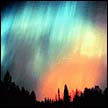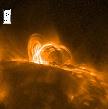
Some conditions in space have the potential to seriously affect us on Earth. We call these conditions "space weather". The causes can include radiation storms and ejections from the Sun as well disturbances in the Earth's magnetic field caused by the Sun. Besides triggering beautiful auroras, these solar storms can damage satellites, disrupt power grids and electrical systems, interfer with cell phones and other communications, and disturb animal movements. They can even threaten astronauts and high-flying airplanes with their radiation!

 About
60 km (40 miles) above us lies the Earth's ionosphere, a
desolate place where continual blasts of particles and energy
from the Sun hit our atmosphere so strongly that electrons
are stripped away from their nuclei. This "ionized" region,
where electrons and nuclei run around freely, is a plasma
which we call the ionosphere.
About
60 km (40 miles) above us lies the Earth's ionosphere, a
desolate place where continual blasts of particles and energy
from the Sun hit our atmosphere so strongly that electrons
are stripped away from their nuclei. This "ionized" region,
where electrons and nuclei run around freely, is a plasma
which we call the ionosphere.
The free electrons in the ionosphere have a strong influence on the propagation of radio signals. Radio frequencies of very long wavelength (very low frequency or "VLF") "bounce" back off the ionosphere thus, conveniently for us, allowing radio communication "over the horizon" and around our curved Earth.
The ionosphere reacts strongly to the intense x-ray and ultraviolet radiation released by the Sun during a solar flare, solar storm, or coronal mass ejection. By monitoring the signal strength from distant VLF transmitters and noting unusual changes as the waves bounce off the ionosphere, we can monitor and track these disturbances.
To monitor a VLF signal, we need a radio receiver which can "tune" to very low frequency stations, an antenna to pick up these VLF signals, and a computer to keep track of the data. Since most consumer radios cannot pick up the very low frequence signals, we need to build our own radio receiver and our own antenna. This combination of receiver and antenna we call a Sudden Ionospheric Disturbance Monitor (SID).